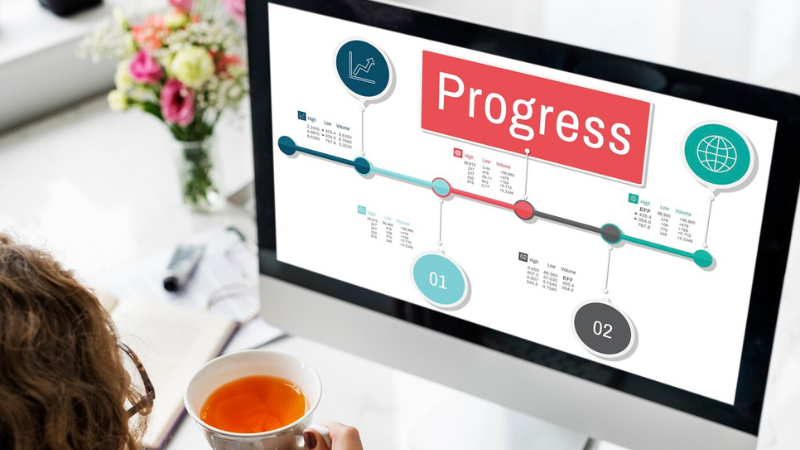A project management office (PMO) within an organization helps in managing different projects efficiently while ensuring they deliver to the client on time and with top-notch quality.
Although setting a PMO is not an entirely new concept, it has significantly evolved in the past few years.
From guiding the upper management on projects and forming standards and best practices to taking part in leadership and decision-making, a PMO’s functions are crucial and rewarding.
In this article, I’ll discuss with you all about PMOs, their types and benefits, and how to create a project management office in your organization.
Let’s begin!
What Is a PMO?
A project management office (PMO) is a department or team within an organization that administers project management processes, technologies, people, standards, and practices.

This team documents all the details of a project, including the client requirements, goals, budget, people working on it, budget, technologies used, and so on. It also directs people and encourages them to achieve the key metrics while executing the project.
Apart from that, a PMO participates in managing projects strategically by monitoring projects and reporting on them.
The standards and practices a PMO defines must be implemented by everyone associated with a project. It could comprise of many people:
- Project managers to manage different projects
- A PMO director or a PMO manager manages the overall PMO activities and guides project managers
- Project coordinators to handle different project aspects like technicality, logistics, collaboration, coordinating meetings, tracking status, and so on
As a result of PMO guidance, project teams can add more value to the clients by submitting quality projects on time. Meanwhile, the organization can obtain better returns on investments (ROI) by completing projects within budget. A PMO also helps minimize risks, errors, and other inefficiencies in a project and its delivery.
Since the functions of a PMO are diverse and crucial, doing everything can require an overwhelming amount of effort along with time and resources. To this, you can use a PMO software solution to have a complete view of your projects and automate various processes to improve efficiency, collaboration, and productivity.
However, in the modern business arena, PMOs can strategically propel business transformation by taking part in decision-making, leadership, and advising the governance teams and senior management.
Types of PMOs
#1. Supportive PMO
A supportive PMO serves more like a consultant to the organization’s management team. This is why it’s also called advisory PMO.

This department is responsible for documenting and storing all the projects and their details, advising managers on projects, and framing standards, policies, and best practices. It also deals with providing training and development for managers and team members.
Supportive PMOs exercise minimal control in project management. So, the final decision on any advice depends on the upper management or project manager.
#2. Controlling PMO
A controlling PMO, as the name suggests, exercises some level of control in project management. It frames guidelines, standards, policies, and best practices and requires everyone to follow them.
#3. Directive PMO
A directive PMO exercises a high level of control in project management. This is why it can direct and enforce standards and policies and ensure their uniform implementation. It directs project execution, administering each task, role, and process. It aims to make the project successful in terms of quality, meeting the deadline, and achieving customer satisfaction.
Sometimes, an organization can take the hybrid approach by combining the types of PMOs if needed.
Roles and Responsibilities of a PMO

A PMO within an organization is set up to guide project teams so they can achieve better outcomes like completing projects on time while ensuring quality in order to delight customers and enhance their bottom line.
Although every organization and its projects and needs are different, some of the common roles and responsibilities of a PMO are common, including:
Project Planning and Management
A PMO oversees its planning and management by understanding every detail of a project. It highlights the key deliverables, goals, budgets, and tasks and helps in forming the team members who will work on the project.
It advises the management team whether taking up the project will be a beneficial deal for the organization or not by carefully analyzing the project’s scope, requirements, and cost-to-benefit ratio. It also verifies if the project aligns with the organization’s goals and values.
Defining Techniques, Best Practices, and Policies
A PMO defines a project management technique based on the project’s unique needs and delivery timeline. There are different project management techniques a PMO can consider – agile, scrum, waterfall, lean, Kanban, etc.

For example, if your client wants you to deliver a software solution within a shorter time frame, you may go for agile project management.
Moreover, a PMO is responsible for framing the policies and standards that each member of the project team has to follow. Take into consideration the quality of deliverables, timeline, security, safety, etc., while framing the policies.
In order to ensure the best possible outcomes, a PMO also creates a list of best practices, which can include tools, processes, ways, etc. to work on the project and maintain it.
Managing Resources
Resource management is a key function of a PMO. This wing of an organization manages resources dedicated to a project. It includes workforce, time, budget, tools, technologies, and so on.
The PMO decides what project would need which resources and how much and makes decisions accordingly. It takes into consideration schedules, priorities, and expenses to make decisions and allocate resources.
This way, the PMO aims to optimize resource consumption, ensuring minimal wastage.
Documenting and Reporting

A PMO documents details of each project, like client, objectives, deliverables, people working on the projects, budget, technology used, processes followed, reports, performance, etc. It works like a central hub where you can find project-related data, which might be helpful in the future.
A PMO also reports project status and inconsistencies to senior leaders and key decision makers.
Measuring and Improving Metrics
To delight your clients, you must ensure to provide them with high-quality project deliverables. And the best way to do that is by measuring its quality and performance and improving it before handling the project to the client.
The PMO keeps on measuring the performance of workflows and individuals working on the project. It tracks the status of the project and ensures that it is completed on time without compromising quality.
Aiding Decision Making
A PMO can advise senior management while making certain decisions related to projects. Since this department administers the overall project, it’s familiar with every detail and what’s good or bad for the organization, project, and client.
A PMO can aid in instances like choosing suitable team members to work on a project, defining a budget, allocating resources, and more.
Training and Skill Development

A PMO provides training and skill development to project managers and their team members. The aim behind this is to keep employees up-to-date with the latest tools, technologies, and technologies. It will not only help them improve their project management skills but also help them add more value to the projects they work on.
Maintaining Corporate Culture
A PMO fosters a healthy corporate culture by ensuring everyone involved with a project is respected and follows defined policies and standards no matter what their designation is. It establishes clear communication channels and transparency between the entire project team so that each member feels free to share their ideas and opinions on the project, minimizing friction.
Key Components of a PMO
#1. Governance and Leadership
In this rapidly changing world, businesses need to keep up with technology, digital transformation, globalization, and changing customer demands. So, modern PMOs take the front stage by exercising leadership and governance in project management.
A PMO studies the overall requirements of a client and ensures they are met by enforcing standards and best practices in project management, leading the project team, and controlling project execution.
#2. Processes and Methodologies
Project management processes and methodologies are crucial since these decide the course of a project.

A PMO chooses a suitable project methodology (like Scrum, Agile, Waterfall, etc.) based on the requirements and deadline. Similarly, it also guides the overall processes that must be implemented throughout the project lifecycle, from planning and execution to testing and delivery.
#3. Tools and Technology
The PMO chooses the suitable tools and technologies needed to complete a given project. For this, the team carefully analyzes the project and its objectives and decides on the equipment that can ease the process and enhance productivity while minimizing the timeline and costs.
The tools and technologies they choose can be for each stage in the project lifecycle. There are many project management tools you can find for planning, executing, tracking, documenting, reporting, testing the performance, simulating, and delivering the project.
Benefits of Establishing a PMO
The benefits of establishing a PMO are:
Improved Project Success Rates

Setting up a PMO helps in improving your projects’ success rates since the whole team will be dedicated to streamlining the project and achieving goals within the deadline and with quality.
Enhanced Resource Allocation and Utilization
With defined roles and responsibilities, it becomes easier for you to allocate resources among the team effectively based on their roles.
You can also track how each member is utilizing resources and optimize it.
Better Decision-Making
As the PMO has complete details of the projects and the client needs, it can assist and improve decision-making through data-driven insights.
Steps to Establishing a PMO
#1. Evaluate Your Current Project Management State
To establish a PMO in your organization, evaluate the current state of your project management.

For this, you might want to determine the performance of your past projects and consider client and employee feedback. This will help you understand the issues in project management and how setting a PMO would solve them.
And when you decide to apply for a PMO, choose the suitable type (supportive, controlling, or directive) based on your organization’s objectives as to how much control you want to give to your PMO.
#2. Define Objectives and Scope
It’s important to define the objectives and future scope of your PMO in order to set clear expectations, guide the team going forward, and overcome project management issues.
For this, have a discussion with your leaders, project managers, and key decision-makers. Outline all the things you want to achieve with a PMO, like the functions, roles and responsibilities, resources, future expansion, and so on.
#3. Develop a Roadmap

Once your objectives are clear, start creating the roadmap or your PMO strategy. It will include various aspects of your project in terms of function, structure, and discipline. Making strategies around these aspects will ensure the roles, responsibilities, and goals are clear. For that,
- Set standards, policies, and systems to which everyone in the PMO must adhere
- Choose projects aligning with your business goals and values
- Find out bottlenecks and settle them
- Hire right people for the right job
- Invest in skill development and training
- Adopt right tools and techniques for each project
- Define disciplinary actions and values
- Set up proper communication channels
#4. Build the PMO Team
Typically, a PMO team comprises a PMO manager, senior project managers, junior project managers, project coordinators, analysis, and administrators.
So, choose reliable and skillful people in your project management office who can align with your vision and to execute their jobs effectively. You can also work towards their training and development.
#5. Implement Processes and Tools
After building your PMO team, start streamlining your projects. Implement project management methodologies and processes based on the project needs and goals. Similarly, choose the tools and technologies accordingly that can ease and accelerate workflow, minimize costs, enhance productivity.
#6. Monitor and Adapt

Keep monitoring the performance of your PMO team by measuring metrics like project delivery timeline and quality, client satisfaction rates, etc. Check whether everyone is adhering to the defined standards and policies and are following best practices and code of conduct.
If you see any inefficiencies or issues, resolve them quickly. Also, stay updated with recent business changes and technologies and adapt to them.
Best Practices for PMO Success
#1. Foster Stakeholder Engagement
Involve all your stakeholders in your project management, including the key decision-makers, managers, and clients.
Take their feedback and opinions in various processes at each stage of the project management lifecycle and improve them.
#2. Focus on Change Management
Due to rising competition, you should focus on making necessary changes that can elevate your project’s quality and result in client happiness.
Adapt to the latest technologies and tools for communication and project execution to enhance project efficiency.
In addition, be aligned with the needs of your customers. They might need some last-minute changes or changes during any stage of the project. You must be ready to adapt to them
#3. Measure and Report Progress

A PMO must always document each detail of a project and report its progress status to the upper-level management.
This will enable the management team to detect issues and resolve them faster. It will ensure the projects are completed on time and with quality.
Common Challenges and Their Solutions
Some challenges of PMO and their solutions are as follows:
- Changing methodologies: Clients’ requirements may change, which can change the project management methodology. This can cause difficulties for your team to adapt to sudden changes.
To overcome this, keep the objectives of the project clear to eliminate the changes of these sudden changes.
- Improper resource allocation: If you don’t allocate resources properly, it will make it difficult for your PMO to achieve the desired goals. Team members could be deprived of needed resources like sufficient time, tools, etc., which can reduce their productivity.
To overcome this, plan resource management and allocate them strategically based on who needs what resources and for how long.
- Communication gaps: Communication gaps between the team may result in reduced productivity, lack of awareness, reduced trust, and friction.
So, provide multiple communication channels to team members no matter how far they are working from. Encourage everyone to be transparent and engage proactively.
Case Study

Cognizant is a consulting and professional services company with 300k+ employees worldwide.
The company wanted to modernize its traditional processes, which hindered visibility across various programs and attracted security issues.
Cognizant built a multidisciplinary department to create and implement enterprise PMO by partnering with Planview. This helped them streamline and automate their project management processes and enhanced security.
FAQs
The 4 P’s of PMO are:
• People
• Perception
• Priorities
• Performance
They are:
• Leadership
• Cost management
• Resource allocation
• Communication
• Risk management
Wrapping Up
I hope this article on the project management office gives you an idea of the concept, its importance for your organization, and how to create a PMO.

